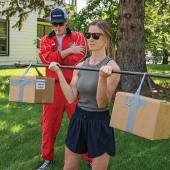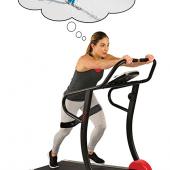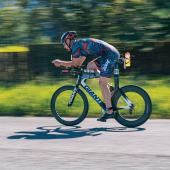Preventing Shoulder Injuries
Commonly thought of as a single mechanism, the shoulder is actually a complex of four different joints that allows you to move your arm in a number of directions. The shoulder has the greatest range of motion of any joint in the body and thus it is designed primarily for mobility. It’s no surprise, therefore, that many of the injuries seen in the shoulder result from instability issues. Fortunately, you can significantly reduce your risk of these injuries with an appropriate strengthening program.
FUNCTIONAL ANATOMY
The joint that most people identify as the main shoulder joint is the glenohumeral joint, which is a “ball and socket” joint. The socket component is called the glenoid and is part of the shoulder blade, or scapula. The ball is the top end of the upper arm bone, or humerus. The articulation between the glenoid and the head of the humerus is therefore called the glenohumeral joint. The socket portion is very shallow—and therein lies the problem. Envision a golf ball sitting on a golf tee. Even non-golfers know it doesn’t take much effort to knock the ball off.
Because of the bony anatomy of the shoulder, we rely primarily on the muscles around the shoulder girdle to provide much-needed stability. This is where the rotator cuff comes in. Four short muscles forming a cuff-like shape lie beneath the big deltoid muscle and run from the scapula to the humerus. Their main function is to hold the humerus in place within the glenohumeral joint. When the arm is raised, the rotator cuff muscles act together to pull the head of the humerus down and in to compress it against the glenoid—and any time joint surfaces come tightly together, the stability and therefore the function of the joint is greatly improved. The rotator cuff muscles also help to rotate the arm outward and inward.
The muscles around the shoulder blade—called the scapular muscles—also have an important stabilizing role by keeping the scapula in place and thus providing a stable platform for the head of the humerus. Think about the golf ball—you can’t keep it steady if the tee is moving all over the place. The two main scapular stabilizers include the middle trapezius and the lower trapezius. These muscles also move the scapula downward and backward to improve posture.
Other muscles that cross the shoulder joint function primarily to move the arm. These are called the prime movers and are also known as the “South Florida beach muscles”—i.e., the deltoids, pectorals, biceps, lats, and triceps. They tend to be longer muscles that attach further from the shoulder joint. They therefore have a good mechanical advantage to move the arm but are not good at stabilizing the humeral head.
Together all of these muscles work to raise and lower the arm in all directions, allowing an individual to hit a tennis ball, catch a softball, swing a golf club, throw a Frisbee, etc. Just as important, the shoulder muscles also work to control movement of the body (and objects) by allowing for critical pushing and pulling activities in both vertical and horizontal directions. Paddling a kayak and climbing a rock face are examples of pulling activities. Pushing activities include throwing a shot put and setting a volleyball. The shoulder also functions with the body core, hips, and lower extremities in many outdoor and athletic activities. Think of poling while going uphill in cross country skiing, or how the trunk and lower body work together to slow the arm after throwing a baseball.
COMMON INJURIES
Shoulder injuries are quite common and usually involve some aspect of dynamic instability or muscle imbalance. The three most common among athletes are impingement syndrome, rotator cuff injuries, and glenohumeral joint dislocations.
Impingement syndrome describes the pain originating from compression of the rotator cuff tendon or the biceps tendon between the head of the humerus and the bony arch just above the glenoid. Any condition that causes a narrowing of the space between this arch and the humeral head—called the subacromial space—can lead to tendon pinching with subsequent irritation and inflammation. One of the major causes of narrowing is an upward migration of the humeral head when raising the arm. This is usually because the rotator cuff is not strong enough to effectively pull the humeral head down and into the glenoid. Poor posture also decreases the volume in the subacromial space. Athletes engaging in overhead sports and activities such as tennis, volleyball, rock climbing, swimming, and baseball are especially vulnerable to impingement.
Rotator cuff injuries can result from repetitive micro-trauma (overuse) or from a single traumatic episode. With overuse, excessive demands are placed on the rotator cuff muscles. In throwing sports and other overhead sports, the rotator cuff contracts vigorously to slow or decelerate the arm. This causes considerable force on the tendons, which leads to small tears and tendonitis. In single-event episodes, the rotator cuff tendons can tear completely or partially when they are stretched as the humerus pulls away from glenoid. This may occur when a downhill skier falls onto an outstretched arm or when a mountain biker takes a header over the handlebars.
Shoulder dislocation is when the head of the humerus slips entirely off the glenoid, usually in a forward direction. This is a significant injury and can cause tearing and damage to a number of ligaments and tissues at the shoulder. What usually happens is a combination of humeral abduction (the humerus is lifted straight out to the side) and outward rotation. Envision a whitewater kayaker assuming the brace position when a huge wave pushes the hand and forearm backward. If this motion occurs quickly and excessively, dislocation may occur. Partial dislocations may also occur; these involve a good deal of instability and repeated episodes can cause pain, tissue damage, and impaired function.
INJURY PREVENTION
Simply put, the secret to preventing shoulder injuries is to strengthen the rotator cuff and scapular muscles to allow for coordinated and stable shoulder movement. Yet these muscles are often overlooked in many strength-training programs. Many athletes still over emphasize the development of those South Florida beach muscles—the chest and arm muscles that contribute to a muscular appearance. Overdeveloping the chest by performing too much pushing and pressing (activities like the bench press and overhead/military press) can lead to postural and shoulder problems by under-developing the scapular and rotator cuff muscles. Pushing exercises are okay for strength, but pulling exercises should be emphasized for injury prevention to improve scapular stability. Moreover, standing shoulder exercises such as lateral raises and forward raises may load the shoulder excessively and should be used with caution.
Balance training is also important in preventing shoulder injuries that may occur from falling. Performing some shoulder training together with core, hip, and lower extremity training may also decrease the risk of shoulder injuries.
Performing athletic and daily activities requires strength, flexibility, and endurance. If the body does not have sufficient levels of each of these, injury is likely. Appropriate upper body conditioning and strength training can certainly make your shoulder less vulnerable to injury and allow you to enjoy your favorite outdoor activities with fewer concerns.
The following program is designed to maintain balance among all of your shoulder muscle groups while focusing on the rotator cuff and the scapular muscles. In general, these muscles not only need to be strong, they need to resistant to fatigue. Thus the program is endurance-biased. You should generally perform two to three sets of 15-20 repetitions of each exercise using relatively low weight. Perform them three times weekly.
- Y lifts: Lie on your stomach on the floor with the arms 45° above shoulder level, thumbs pointed up towards the ceiling. Raise both arms up off the floor trying to initiate the movement with your shoulder blades. Start with hands only and progress to one- to three-pound dumbbells.
- T lifts: Lie on your stomach on the floor with the arms 90° straight out to the side, palms down. Raise both arms up and rotate them as you do so by pointing your thumbs toward the ceiling. Focus on pinching your shoulder blades together. As with the Y lift, start with hands only and add weight as your strength increases.
- One-arm, one-leg row: Stand on one foot with that knee bent 30°-45°. In the opposite hand hold the cord or pulley handle attached in front at chest height. Start with the thumb pointing down and perform a one-arm row as you straighten the knee. At the end position the palm should face up. Focus on pulling aggressively, bringing the elbow well behind the body. Repeat with opposite arm/leg.
- Elbow pulls: Use a cord or pulley attached in front at waist level. Stand with the feet shoulder-width apart, knees slightly bent, and with a slight forward lean. Hold grips with thumbs up and with elbows at 90° and close to the rib cage. Maintain the 90° elbow position and pull the cord straight backward quickly.
- Side lying external rotation: Lie on your side with the top arm resting against the side of your trunk with that elbow at 90° and with the forearm resting across the abdomen. Hold a one- to three-pound dumbbell and rotate your upper arm outwardly to raise the forearm up and back towards the ceiling. Keep the elbow tucked at the side. Repeat on opposite side.
- Scarecrow: Stand with both arms straight out to the sides at 90°. The elbows are also bent at 90° with the forearm dangling downward towards the floor. Simultaneously raise both forearms upward and backward by rotating the upper arms outwardly. Maintain a 90° position at both joints. Use one- to three-pound dumbbells.
- Standing two-arm overhead medicine ball throw: Stand with feet shoulder width apart and hold a two- to three-kilogram medicine ball overhead in both hands. Throw the ball powerfully against a concrete wall or to a partner.
- Alternating overhead dumbbell press: Stand with one dumbbell resting on each shoulder, palms facing each other. Alternately raise one arm up overhead rotating the dumbbell as you do so that the palm faces forward at the top. Alternate arms each repetition.










